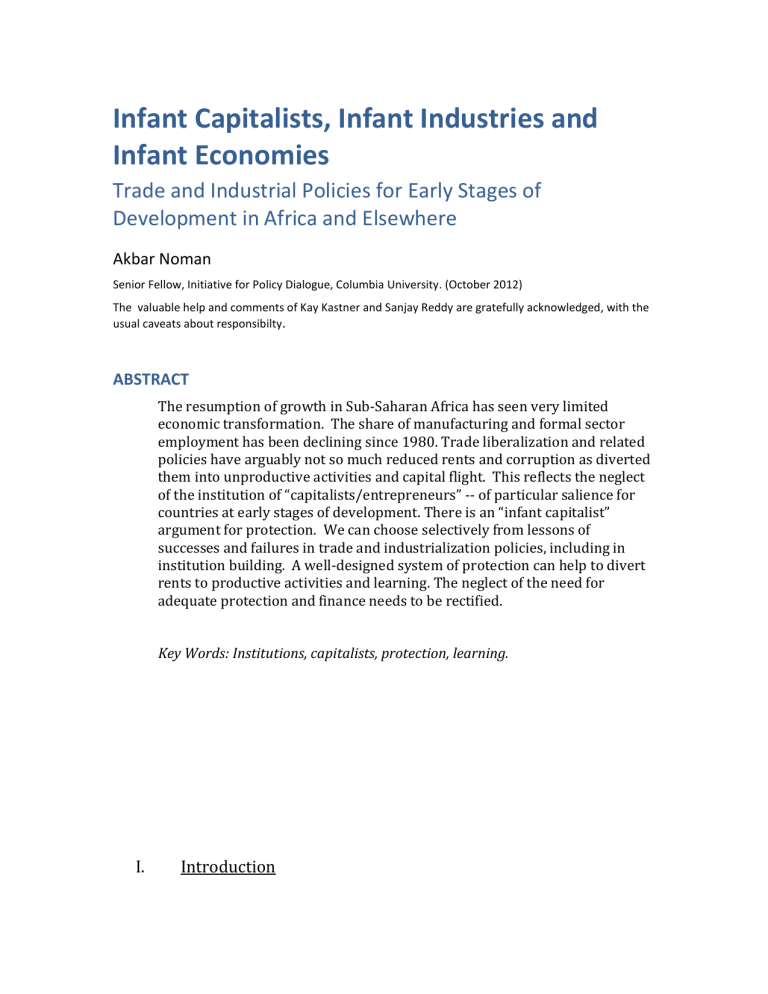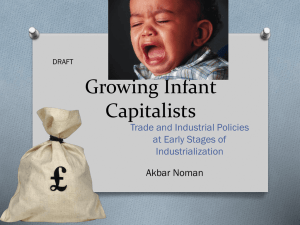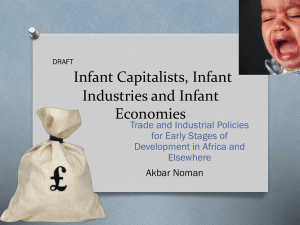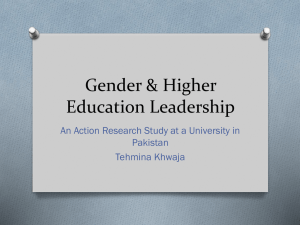Infant Capitalists, Infant Industries and Infant Economies

Infant Capitalists, Infant Industries and
Infant Economies
Trade and Industrial Policies for Early Stages of
Development in Africa and Elsewhere
Akbar Noman
Senior Fellow, Initiative for Policy Dialogue, Columbia University. (October 2012)
The valuable help and comments of Kay Kastner and Sanjay Reddy are gratefully acknowledged, with the usual caveats about responsibilty .
ABSTRACT
The resumption of growth in Sub-Saharan Africa has seen very limited economic transformation. The share of manufacturing and formal sector employment has been declining since 1980. Trade liberalization and related policies have arguably not so much reduced rents and corruption as diverted them into unproductive activities and capital flight. This reflects the neglect of the institution of “capitalists/entrepreneurs” -- of particular salience for countries at early stages of development. There is an “infant capitalist” argument for protection. We can choose selectively from lessons of successes and failures in trade and industrialization policies, including in institution building. A well-designed system of protection can help to divert rents to productive activities and learning. The neglect of the need for adequate protection and finance needs to be rectified.
Key Words: Institutions, capitalists, protection, learning.
I.
Introduction
2
Adam Smith explicitly assumed the existence of a class of capitalists. He spoke of a “previous accumulation” of wealth in the economy into the nature and causes of whose wealth he was inquiring. This “previous accumulation” predated and preconditioned his analysis: "the accumulation of [capital] stock must, in the nature of things, be previous to the division of labour, so labour can be more and more subdivided in proportion only as stock is previously more and more accumulated" 1 .
Karl Marx can be said to have followed Smith in making that assumption, translating “previous” as “ursprunglich” in German, which his translator rendered back into English as the famous “primitive” accumulation 2 . By being embellished by Marx and becoming part of the Marxist lexicon,
“primitive accumulation” presumably acquired the connotations that perhaps led to its neglect by economists of other persuasions. Marx criticized Smith for being ahistorical in his explanation but agreed on its essentiality.
3
The fundamental point on which Smith and Marx agree is that the accumulation of capital, at any point in time, depends on some already existing capital accumulated earlier to invest in the production process.
Hoff and Stiglitz remark that ”in leaving out institutions, history and distributional considerations, neo-classical economics leaves out the heart of development economics” 4 But even the recent large literature on institutions, including notably those required for the existence and proper functioning of markets, ignores the institution implied by
1 Adam Smith ([1776] 2003), The Wealth of Nations (Bantam Dell), p. 350. “Stock” is Smith’s term for capital stock. Smith elaborates that for example, in a market society, "a weaver cannot apply himself entirely to his peculiar business, unless there is beforehand stored up somewhere, either in his own possession or in that of some other person, a stock sufficient to maintain him, and to supply him with the materials and tools of his work, till he has not only completed but sold his web. This accumulation must, evidently, be previous to his applying his industry for so long a time to such a peculiar business" (Smith [1776] 1976).
2 Michael Perelman (2000) The Invention of Capitalism: Classical Political Economy and the Secret
History of Primitive Accumulation (Duke University Press) p. 25
3 In highlighting the historical process, Marx developed a different meaning of primitive accumulation in that he linked it to the notion of capital as "class relation" rather than as "stock."
Given that "the capital-relation presupposes a complete separation between the workers and the ownership of the conditions for the realization of their labour," it follows that "the process … which creates the capital-relation can be nothing other than the process which divorces the worker from the ownership of the conditions of his own labour." By turning "the social means of subsistence and production into capital, and the immediate producers into wage-labourers," this process is therefore the basis of class formation. Thus, the "so-called primitive accumulation is nothing else than the historical process of divorcing the producer from the means of production", Karl Marx, ([1867]
1976). Capital. Vol. 1. (Penguin, New York) pp. 874-875.
4 Hoff, K. and Stiglitz, J.E. (2001) “Modern Economic Theory and Development” in Meier, G. and
Stiglitz, J. (eds) (2001) Frontiers of Development Economics (Oxford University Press, New York), p.390.
3
“previous” or “primitive” accumulation. In other words, it implicitly assumes the existence of economic agents who have monies to invest and the ability to do so --capitalists and entrepreneurs. Incentives simply determine their willingness, but not their ability, to invest how much and where.
But almost by definition that assumption is of dubious validity for economies at early stages of development like many countries in Sub-
Saharan Africa today or many in East and South Asia yesterday and elsewhere the day before yesterday.
Some of the earlier literature on development with its emphasis on capital accumulation as being central to development did pay some attention to the issue of the absence or weakness of the institution implied by Smith’s “previous” or Marx’s “primitive” accumulation.
5
More often than not, the focus was not so much on the complete absence of capital and capitalists as their inadequacy. As Peter Evans remarks,
“Gerschenkron’s work on …late industrializers confronting …technologies with capital requirements in excess of what private markets were capable of amassing were forced to rely on the power of the state to mobilize….resources…..The crux of the problem faced by late developers is that institutions that that allow large risks to be spread across a wide network of capital holders do not exist …..Hirchman takes up this emphasis on entrepreneurship as the missing ingredient for development in much more detail.” 6
But as noted above, the large literature on the economic role of institutions that has emerged rapidly in recent years, implicitly assumes the existence of capitalists/entrepreneurs in adequate measure.
7 Thus,
5 Gerald Meier, for example, remarks that “Believing that [in] a developing country …..the supply of entrepreneurship was limited and large structural changes …were needed the first generation of development advisers …turned to the government …to promote capital accumulation, utilize reserves of labor, …undertake policies of deliberate industrialization…..”, (emphasis added); Meier, G. (2001)
“The Old Generation of Development Economists and the New” in Meier, G. and Stiglitz, J. (eds)
(2001) Frontiers of Development Economics (Oxford University Press, New York). Also see (See for example, Papanek (1967); Lewis (1971); Little, Scitovsky and Scott (1971), where the issue of creating or strengthening the institution of the private sector or capitalists/entrepreneurs is discussed. Elsewhere, advocates of public sector led industrialization based their case partly on the weakness of the private sector.
6 Peter Evans, “The State as Problem and Solution: Predation, Embedded Autonomy and Structural
Change”, excerpted in Meier, G. and Rauch, J, (eds) (2005) Leading Issues in Economic Development
(Oxford University Press, New York and Oxford), p. 543.
7 For a general overview and critique of this literature, see Mushtaq Khan 2012), “Governance and
Growth: History, Ideology and Methods of Proof” in Akbar Noman et.al. (eds) op.cit.. Also see, in the same volume, Thandika Mkandawire (2012) “Institutional Monocropping and Monotasking in
Africa.”
4
Dani Rodrik in answering the question of which institutions matter according to the new institutional literature identifies the following five:
(a) property rights, (b) regulatory institution; and institutions for (c) macroeconomic stabilization, (d) social insurance and (e) conflict management, (whilst adding that in his view participatory politics is a
“meta institution”).
8
An exception has been the attention given to this pre-requisite of successful privatization in the transition economies of Eastern Europe and the former Soviet Union. This was reflected in the schemes for voucher privatization in some of these countries. Some of the critics of privatization, particularly the Russian privatization of the 1990s, blamed the disaster not only on the absence of the “standard” institutions of property rights and contract enforcement that figure so prominently in the institutional literature but also, in effect, of capitalists.
9 This has also been an issue in some of the reform programs of Africa that have also been beset by cases of privatization without the requisite institutional underpinnings.
This essay focuses on the implications of the neglect of the institution of capitalist-entrepreneurs for economic policy in countries at early stages of development. In particular, it is concerned with the fact that whilst the past decade or so has witnessed a reversal in the collapse of growth in
Sub-Saharan Africa (hereinafter simply referred to as Africa) that resulted in its “lost quarter-century”, progress in bringing about economic transformation of the sort that lays the foundations for sustained growth and development remains very limited. Indeed, the share of manufacturing and formal sector employment has been generally declining since 1980.
On average, the share of manufacturing in GDP in Africa fell from 17.5 percent in 1965 to 12.9 percent in 2009. Relatedly, as Noman and Stiglitz point out “there has been little success in exporting manufactures and in attracting foreign direct investment in non-extractive activities. Much of the growth of the past decade or so is accounted for by extractive activities in non-renewable resources – minerals, metals and above all, oil…” 10
8 Dani Rodrik (2007), One Economics Many Recipes: Globalization, Institutions and Economic Growth
(Princeton University Press, Oxford and Princeton), Chapter 5.
9 See, for example, Joseph Stiglitz………………. For other institutional failures that marred privatization in the transition economies of the former Soviet Union and Central Europe, also see Karla Hoff
10 Akbar Noman and Joseph Stiglitz, “Strategies for African Development” in Akbar Noman et.al (eds)
(2012), Good Growth and Governance in Africa: Rethinking Development Strategies, (Oxford University
Press, New York and Oxford), p.8.
5
In section III, we attempt a diagnosis of this phenomenon of deindustrialization or “detransformation” of African economies. Much of it is necessarily speculative and more in the nature of hypotheses than established results of research. Before that, in the next section, we sketch a formal case for infant capitalist protection with minimal mathematics to keep it accessible to a wider audience. The final section makes concluding remarks.
II. The Infant Capitalist Argument
The explicit assumption of Adam Smith and Karl Marx and the implicit one of much (all?) recent institutional literature acquires particular salience at early stages of development. Formally, this can be characterized, along the lines of Greenwald and Stiglitz 11 , as the stage when the economy is embarking on development aimed at moving beyond simple agriculture and crafts to producing output for which capital and learning are important.
By definition, “modern” private sector and its capitalists/entrepreneurs are absent at this stage and all output emanates from sector A which comprises agriculture and crafts, using only labor L (including skills) and
M, which consists of modern manufacturing and employs both L and capital, K, which is owned and operated by capitalists, C.
𝑌 = 𝐴 = 𝑓
1
(𝐿)
M, which consists of modern manufacturing and employs both L and capital, K, which is owned and operated by capitalists, C.
𝑀 = 𝑓
2
(𝐿, 𝐾) = 𝑓
3
(𝐿, 𝐶) {i.e. 𝐾 = 𝑓
4
(𝐶) }
With both sectors, total output
𝑌 = 𝐴 + 𝑀 = 𝑓
1
(𝐿) + 𝑓
3
(𝐿, (𝑓
4
𝐶)
)
C either exists on account of primitive/previous accumulation or must be acquired. There is no foreign capital or capitalist 12 .
11 Bruce Greenwald and Joseph Stigitz (2006) “Helping Infant Economies Grow: Foundations of Trade
Policies for Developing Countries, American Economic Review, 96 (2): 141-6.
12 Alternately, foreign capital/capitalists are very imperfect substitutes for those of the domestic variety or domestic capital/capitalists are a different and necessary factor of production. This is essentially a political economy argument for the need for local capitalists, where “local” could mean a particular ethno-linguistic group like the “bumiputras” in Malaysia.
6
The argument that is elaborated below on the acquisition of C and its impact on Y can be summarized as:
𝐶 = 𝑓
𝑌 = 𝑓
1
5
(𝑇, 𝐹)
(𝐿) + 𝑓
3
(𝐿, (𝑓
5
(𝑇, 𝐹))
Where T stands for tariffs (implicit and explicit) and F for investment finance.
With no protection and no finance for investment there is no capital accumulation and hence no capitalists and no output in M.
The relationship is not monotonic, especially with respect to T. Indeed it can be thought of as having a threshold below which and another above which there is no relationship between C and T (or indeed even a negative one beyond a point as the static efficiency costs outweigh dynamic gains) i.e.
𝑇 ≧
𝑇 𝑎
≦ 𝑇 𝑏
Inevitably at early stages of development, the form of industrial organization is characterized by an absence of divorce between ownership and management of capital. The capitalist and the entrepreneur are one and the
same. So protection stimulates both accumulation and entrepreneurship.
Industrial (or modern sector) entrepreneurship requires capital, which can be borrowed – and much of it typically is, especially at early stages of industrialization --or saved out of profits.
Again, inevitably financial sector is very weak and highly imperfect at the stage we are concerned with. Stock and bond markets do not really exist and the availability of long–term finance is largely characterized by its absence, especially at rates of interest that would allow borrowing for investment that does not yield immediate and very high returns.
The venerable infant industry argument used by Alexander Hamilton, the first Treasury Secretary of the United States to establish the system of protection under which US industrialized 13 can be said to have matured some six years with the infant economy argument of Greenwald and Stiglitz.
14
The essence of these arguments is well known and revolves around learning and spillovers. Activities in countries at an early stage of development cannot compete with those already well-established in more advanced economies and protection is necessary to help them grow, learn and become competitive. That case is extended or adapted in this essay to what we refer
13 See Ha-Joon Chang (2002), Kicking Away the Ladder: Development Strategy in Historical Perspective
(Anthem Press, London)
14 Greenwald, B. and Stiglitz, J.E. (2006)
7 to as the infant capitalist argument: protection by reducing risks and boosting
profits can help create and nurture capitalists and enable learning. It does so by facilitating both higher accumulation (savings) out of profits and bigger borrowings – as larger profits and reduced risks in the protected activities enhance creditworthiness.
If the capitalist and the entrepreneur are one and the same then capital accumulation and entrepreneurship are intertwined at “infancy” and physical and human capital are accumulated jointly. Acquiring physical capital is necessary for learning, which in turn facilitates further accumulation.
Moreover, as argued below, a well-designed structure of protection can also help to improve the quality of rents by directing them into industry and entrepreneurship from arguably the more wasteful forms that rents have often taken, particularly after trade liberalization in many countries, notably in Africa.
III. Infant Capitalism in Africa: Facts, Speculations and Hypotheses
At the time of independence, African countries typically can be characterized as lacking a class or private sector with the wherewithal to become entrepreneurs in “modern” activities. More precisely, to the extent such groups existed, they predominantly comprised foreigners or ethnic minorities of relatively recent origin (such as Indians and Lebanese in parts of East and West Africa, respectively).
15 .
Arguably, at independence there was probably a greater divorce between economic and political elites in Africa than anywhere else. This would seem to underlie the emergence of the political economy of what Meles Zenawi calls the “predatory state” in Africa.
16 At any rate, this is likely to have provided the basis for an attitude of ambivalence, at best, towards the private sector and of resort to public ownership of industries that characterized much of Africa, especially in the 1960s and 1970s.
Many countries in the region still feature predominantly infant or toddler indigenous capitalists in manufacturing or modern services. There is a clear political economy case to protect, create or nurture them.
15 This is analogous to the situation in Malaysia that led to the New Economic Policy (NEP) launched in 1971 to promote the development of Bumiputra (indigenous Malay) businesses/capitalists/private sector. Whilst controversial and flawed in some respects, NEP is credited with possibly staving off ethnic conflicts.
16 Meles Zenawai (2006) African Development: Dead Ends and New Beginnings (excerpts) available at http://policydialogue.org/events/meetings/africa_task_force_meeting_manchester_2006/materials/
8
Whilst some individuals and groups have acquired significant wealth from rent seeking, it does not serve the purpose that previous or primitive accumulation performed in Adam Smith’s and Karl Marx’s economy. That is to say, there is little or no incentive to invest in modern, transformational sectors in which learning is important or indeed to invest domestically as opposed to transferring assets abroad.
The sources of wealth are predominantly trading or unproductive rents in a system of incentives that emerged from the economic reforms that are commonly referred to as of the Washington Consensus (WC) variety.
17
Typically, rents have taken the form of kickbacks on government contracts, insider wheeling and dealing associated with contracts for mineral resources or real estate or privatization or just plain theft. Such wealth is also more likely to end up overseas than that emanating from investment in industry.
Trade and financial sector reforms aimed at liberalization have often taken away the incentives to invest in domestic production activities. As Azizur
Rehman Khan put it, such reforms have often taken away bad incentives but replaced them with worse ones. 18
Nicholas Stern argues that the “central policy question here is: How can a country develop governance and institutions to support entrepreneurship and well-functioning markets ……The policy challenge is thus the promotion of growth through improvements in the investment climate: it is about creating conditions so the pie keeps expanding. It is not just a question of how to avoid or limit losing slices of the pie as measured by Dupuiy-
Harberger triangles or even rent-seeking quadrilaterals….” 19
However, the investment climate and related governance reforms of the type that have become the fashion or part of donor conditionalities, have been very imperfect substitutes for the sort of trade and industrial policies that attract investments in productive, learning activities. More often than not the reform programs ended up by not so much reducing rents as diverting them into unproductive forms.
In contrast, rents acquired via incentives for infant industrialists to invest in infant industries can contribute to structural transformation and learning of
17 See, for example Joseph Stiglitz (2008) “The Post-Washington Consensus Consensus” in Serra,
Narcis and Stiglitz, Joseph (eds) The Washington Consensus Reconsidered (OUP, New York and
Oxford)
18 A.R. Khan (2009) chapter 4 in Quazi Shahabuddin and Rushidan I. Rahman (Eds), Development
Experience and Emerging Challenges: Bangladesh (University Press, Dhaka), especially pages 66-72.
19 Nicholas Stern (2003) “Public Policy for Growth and Poverty Reduction” in Arnott, R., Greenwald,
B., Kanbur, R., and Nalebuff, B.(eds) Economics for an Imperfect World: Essays in Honor of Joseph E.
Stiglitz (MIT Press, Cambridge, Mass and London)
9 the type that succeeded so spectacularly in East Asia and to varying degree elsewhere in Asia and in Latin America.
20
IV. Lessons of Success: Infants Who Grew Up
Rents acquired via incentives for infant industrialists to invest in infant industries can contribute to structural transformation and learning of the type that succeeded so spectacularly in East Asia and to varying degree elsewhere in Asia and in Latin America.
21
Much of the literature on policies for developing countries to catch-up revolves around the interpretation and lessons of the astounding success in several East Asian countries that has been labeled the East Asian miracle.
22
The replicability of the East Asian “model”, especially with regard to trade, industrial and financial policies has been much debated essentially on account of its “governance” requirements. The “developmental state” to which is attributed the success of East Asian style public policy interventions is held to be very difficult to emulate. However, others such as Ha-Joon
Chang, Mushtaq Khan, Noman and Stiglitz, and Meles Zenawi have emphasized that governance is not entirely exogenous and argued that the non-replicability of East Asian policies in Africa and elsewhere is much exaggerated.
23
20 See for example, Robert Wade (1990), Governing the Market (Princeton University Press,
Princeton); Alice Amsden (1989), Asia’s Next Giant (OUP, New York); Ha-Joon Chang (1994) The
Political Economy of Industrial Policy, (Macmillan, London and Basingstoke); Jose Antonio Ocampo
(2012) The Economic Development of Latin America since Independence, (Oxford, Oxford University
Press)
21 See for example, Robert Wade (1990), Governing the Market (Princeton University Press,
Princeton); Alice Amsden (1989), Asia’s Next Giant (OUP, New York); Ha-Joon Chang (1994) The
Political Economy of Industrial Policy, (Macmillan, London and Basingstoke); Jose Antonio Ocampo……
22 The literature is vast. In addition to Amsden (1989) op.cit. and Wade (1990) op.cit; see for example, World Bank (1993), The East Asian Miracle: Economic Growth and Public Policy (OUP, New
York); Ha-Joon Chang (2006), The East Asian Development Experience: The Miracle, The Crisis and the
Future, (Zed Books, London and New York); Bela Balassa , “The Lessons of East Asian Development:
An Overview”, Economic Development and Cultural Change No. 3, April 1988, Supplement; Vol. 36;
Joseph Stiglitz (1996),“Some Lessons from the East Asian Miracle”, The World Bank Research
Observer, Vol. 11, No.2; Stiglitz, J. (2001) "From Miracle to Crisis to Recovery: Lessons from Four
Decades of East Asian Experience," in J. Stiglitz and S. Yusuf (eds.), Rethinking the East Asian Miracle, ,
Oxford: Oxford University Press,. Also see Commission on Growth and Development, The Growth
Report: Strategies for Sustained Growth and Inclusive Development (World Bank, Washington DC)
23 See Ha-Joon Chang’s contribution to this volume. Also see the following essays in Noman, A.,
Botchwey, K,, Stein, H., and Stiglitz, J., (eds) (2012) Good Growth and Governance in Africa: Rethinking
Development Strategies (OUP, Oxford, New York): Mushtaq Khan (2012) “Governance and Growth
Challenges for Africa”; Akbar Noman and Joseph Stiglitz (2012) “Strategies for African Development” and Meles Zenawi (2012) “Neo-liberal Limitations and the Case for a Developmental State”.
10
Whatever one’s views on the replicability of East Asian style policy interventions, the feasibility of success with the sort of infant capitalist promotion outlined above is demonstrated by a highly relevant non-East
Asian case: that of Pakistan. An excellent, detailed study by Gustav Papanek 24 shows how Pakistan created a class of “capitalist-industrialistentrepreneurs” pretty much from scratch almost overnight: in not much more than five years. Protection played a key role.
Papanek notes that “Pakistan like other countries in Africa and Asia, not only lacked industrial entrepreneurs; it seemed unlikely to develop them in the short run……..[but] in fact industry grew rapidly, indeed and was largely developed by private entrepreneurs”.
25 He attributes it at the most proximate level to “annual profits of 50-100 percent on investment” in industry 26 in the early 1950s (which moreover “helped to restrict both capital flight and consumption”).
27 By the late 1950s, Papanek reports, such profit rates had fallen to 20-50 percent. Nonetheless by then enough of a class of industrial entrepreneurs and momentum had been created for industrial growth to continue at heady rates.
Stephen Lewis (1970) and Akbar Noman (1991) also examine how industrialists/entrepreneurs/capitalists emerged and blossomed. At the center of a host of incentives for investment in manufacturing, were rates of protection that provided high and assured profits.
28 With long-term credit at modest interest rates provided in ample measure by two development banks
– Pakistan Industrial Credit and Investment Corporation (PICIC) for large industries and the Industrial Development Bank of Pakistan (IDBP) for medium sized industries – in a context of reasonable macroeconomic stability, investment and accumulation boomed.
The aforementioned Lewis study was undertaken under the rubric of the highly influential OECD research program on trade and industry directed by
Little, Scitovsky and Scott (LSS) that resulted in their seminal synthesis volume and accompanying country studies. 29 Even as LSS noted and criticized the many pitfalls of the protection regime they pointed out that
“within our seven countries, only Pakistan had to discover an
24 Gustav Papanek (1967) Pakistan’s Development: Social Goals and Private Incentives (Harvard
University Press, Cambridge, Mass.), in particular chapters II and III.
25 Ibid. p.29.
26 Ibid. p.33
27 Ibid, p.36
28 Lewis, S.R. (1970), Pakistan; Industrialization and Trade Policies (OECD, Paris). Noman, Akbar
(1991) “Industrial Development and Efficiency in Pakistan: A Revisionist Overview”, The Pakistan
Development Review, Vol. 30, No. 4 (Winter 1991)
29 Little, I.M.D., Scitovsky, T. and Scott, M.F. (1970) Industry and Trade in Some Developing Countries,
(OECD, Paris)
11 entrepreneurial class” and as the accompanying country study, Lewis (1971) showed, it had done so well within a decade.
LSS and Lewis agree with Papanek (1967) on this count but they differ from him, in emphasizing the static inefficiencies generated by protection. Indeed,
LSS go as far as to suggest that the rapid industrialization that Pakistan experienced was so inefficient that value-added at world prices remained almost negligible. However, this claim of LSS has been subjected to critical scrutiny with the upshot that there is little doubt that these inefficiencies are much exaggerated 30 . The system of protection in Pakistan had many excesses and irrationalities and attendant inefficiencies but they were nowhere near as bad as claimed by LSS and Balassa (1971) 31 . Moreover, there was considerable learning with productivity growth and declining inefficiencies over time 32 .
Indeed, Pakistan’s GDP and industrial growth accelerated to what came to be known as East Asian miracle levels before Korea, as did the emergence and growth of manufactured exports. Such exports in the mid-1960s exceeded those of Korea by a substantial margin. Korea actively sought to learn from
Pakistan, including by sending the staff of its economic ministries for training in Pakistan.
Whatever the inefficiencies of Pakistan’s industrialization, there are, arguably, some important lessons about creating or building the institution of capitalists/entrepreneurs, albeit whilst avoiding the excesses that vitiated
Pakistan’s trade and related policies. The rates and variability of protection in Pakistan during the 1950s and 1960s were so high as to leave considerable scope for improvements while still providing the critical level of incentives for the building of a group or class of economic agents with the ability and willingness to invest in modern, transformational activities.
V. Concluding Remarks
The case for infant capitalist or any other rationale for protection has to be tempered in the light of the many failures of interventionist policies for trade and industrialization. But the dangers of excessively high and irrational
30 See Noman (1981) op. cit. for the compelling reasons for considering the LSS estimates of inefficiency to be grossly exaggerated and references to other relevant studies, including Kemal, A.R.
(1974) “The Contribution of Pakistan’s Large-scale Manufacturing Industries Towards GNP at World
Prices”, The Pakistan Development Review, vol. 13. No. 1
31 Balassa, B. and Associates (1971) The Structure of Protection in Developing Countries (Johns
Hopkins Press, Washington)
32 See, for example, Ahmed, Meekal (1980) Productivity, Prices and Relative Income Shares in
Pakistan’s Large-Scale Manufacturing (D.Phil. Thesis, Oxford University); and Kemal A.R. (1978), An
Analysis of Industrial Efficiency in Pakistan, 1959-60-1969-70 (PhD thesis, University of Manchester)
12 protection can and should be avoided. We have lessons of failure that were not available or widely appreciated in the 1950s and 1960s and perhaps even in the early 1970s.
The importance of an experimental approach that scales-up successes and abandons failures quickly is one of the lessons of success. However, learning and implementing the lessons of successes and failures well does demand capacities that not all governments have. More precisely, the risks and rewards depend on the particular circumstances of a country including its governance. But governance capabilities are not given and immutable: the question is not only what governance capacities exist at any point in time but what need to be and what can be built up at what speed. This way of posing the question is all too often ignored or neglected.
As noted above, the absence of protection of infants also carries risks.
Inevitably, there are and will be rents and corruption everywhere. The questions are what forms of corruption are most intolerable, what forms can be eliminated and how to minimize the negative effects of corruption and rents and channel them into productive activities and learning. A blanket attempt to eliminate all corruption and rents, as is the vowed aim of the good governance agenda that has become the fashion, may make the pursuit of the best the enemy of the good by a failure to prioritize and by unintended consequences.
Diverting rent-seeking towards rents that accrue from investing in domestic transformational activities such as industry in poor countries can be done by a well-designed system of protection. We have a much better appreciation of the need to avoid extremes of level and variability of protection but some variability is needed: broadly speaking moderately nigh for simple consumer goods in which low income countries have comparative advantage, lower on intermediate goods (none for those that are inputs for exports) and very low or none for capital goods.
Trade policies need to be embedded in a vision, a strategy for economic transformation, in industrialization policies. Managing the moral hazard emanating from socializing risks of investment and accumulation in industry requires ensuring that infants grow and learn. The successful cases provide ample evidence of the role of exports and competition in achieving that: protection and export promotion can co-exist and competition can be gradually increased.
Another challenge is to avoid exchange rate overvaluation in resource-rich and heavily aid-dependent economies. That is beyond the scope of this paper except to point out that such overvaluation is an argument for protection.
Indeed, trade liberalization in such a context can exacerbate the adverse
13 effects of currency overvaluation and arguably did so in some African economies.
This is reflected in the de-industrialization or “de-transformation” of African economies in the lost quarter-century that has not been reversed even as economic growth has accelerated in the past decade or so. Bringing about that reversal; in particular the role that trade policies can play in facilitating
Adam Smith’s “previous” or Karl Marx’s “primitive” accumulation or just plain private sector investment in domestic activities that transform the economy is what we have been concerned with. Infant capitalists establishing infant industries in infant economies need protection. They also need long-term finance at reasonable interest rates. These considerations were neglected in the so-called Washington Consensus inspired reform programs. The neglect remains to be rectified.









